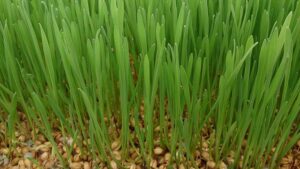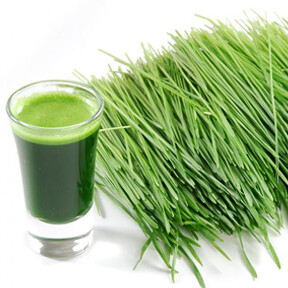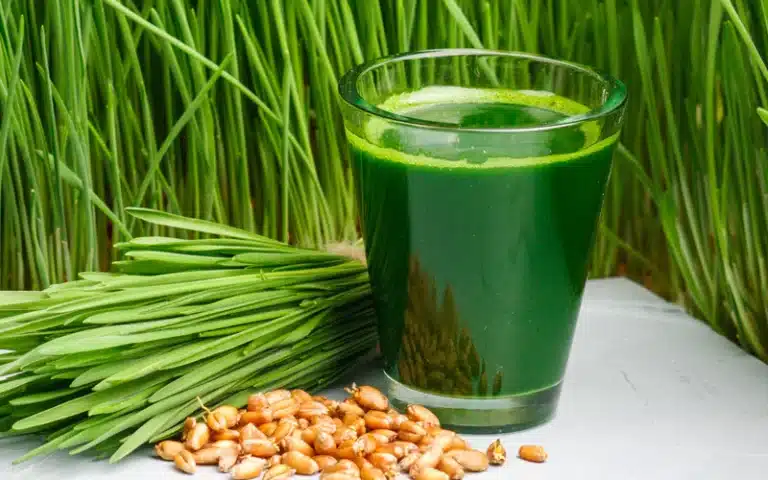Table of contents
ToggleIntroduction to wheatgrass
Wheatgrass is an incredibly nutritious plant that has become a staple in the diets of health-conscious people around the world.
In this article, we'll cover everything from its earthy beginnings in your own garden or windowsill to the impressive health benefits it can offer.
We'll tell you where you can take the step towards radiant health. Wheatgrass contains more than 100 different nutrients, vitamins and minerals.
Among other things, it strengthens your immune system.
Pros and Cons of wheatgrass
| Benefits of Wheatgrass | Disadvantages of Wheatgrass |
|---|---|
| Rich in nutrients: Contains vitamins and minerals | May cause nausea or allergies |
| Detox properties: Cleanses the body | The taste can be unpleasant |
| Strengthens the immune system: Supports the body's natural defences | Requires time for growing and juicing |
| Improves digestion: Supports a healthy digestive system | Excessive consumption can cause gastrointestinal discomfort |
| Natural energiser: Increases energy levels | May interact with certain medications |
| Prevents chronic diseases: Supports general health | Variable quality of products |
| Improves skin and hair health: Strengthens skin and hair | Additional costs may be involved |

Grow your own wheatgrass
Wheatgrass is easy to grow and it's a great way to ensure you always have fresh supplies on hand.
Here are some steps to follow to grow your own wheatgrass:
How to get started
Seed selection and preparation
Choose organic wheat grass seed to ensure they are free from pesticides and chemicals.
Before planting the seeds, rinse them thoroughly and let them soak in water for about 8-12 hours.
Planting and watering
Sprinkle the seeds over coconut flour in a germination tray for microgreens.
Make sure to spread the seeds evenly and cover them lightly with coconut fibre, if you have several germination trays you can also place one on top of the tray to press the seeds into the soil.
Cultivation conditions and care
Wheatgrass thrives best at temperatures between 18 and 24 degrees Celsius and needs plenty of indirect sunlight.
Make sure to water the soil regularly to keep it moist, but avoid overwatering.
After about 10 days, the wheatgrass should be ready for harvest.
Grolys for Wheatgrass
If you do not have a bright window or it is winter, it may be necessary to put one grow light lamp above the wheatgrass so that it can produce the healthy chlorophyll and vitamins.
Why drink wheatgrass juice?
Wheatgrass juice is packed with a wide range of health benefits that make it a great addition to a healthy diet.
Here are some of the reasons why you should consider drinking wheatgrass juice:
Health benefits
Natural detox
Wheatgrass juice is known for its detoxifying effect on the body. It helps purify the blood and strengthens the liver's ability to remove toxins and waste products.
Strengthening the immune system
Wheatgrass contains high levels of vitamins, minerals and enzymes.
It strengthens the immune system and helps the body fight infections.
Improvement of digestion
Wheatgrass juice contains enzymes that help break down food and improve nutrient absorption.
It is also beneficial for bowel function and can help relieve constipation and bloating.
Increased energy
Wheatgrass is a natural source of energy and can provide a boost throughout the day.
Its high chlorophyll and nutrient content helps increase oxygen supply to the cells, resulting in increased energy and endurance.
Prevention of diseases
Wheatgrass juice contains antioxidants that help protect the body from damage caused by free radicals.
This can reduce the risk of developing chronic diseases, such as heart disease and cancer.
Skin and hair health
Wheatgrass juice is known to improve skin health and give a natural glow.
It also contains nutrients that are beneficial for hair health and can help prevent hair loss and stimulate hair growth.

How to make wheatgrass juice
To enjoy all the health benefits of wheatgrass juice, you need to know how to make it properly. Here are some tips and tricks to help you make the perfect wheatgrass juice:
Equipment
You'll need a juicer or a blender to make wheatgrass juice.
A juicer is ideal as it can extract more juice from the wheatgrass than a blender.
Recipe and tips
To make wheatgrass juice, first harvest the fresh wheatgrass.
Rinse it thoroughly and let it dry for a few moments.
Then cut the grass into smaller pieces and add it to the juicer or blender. If you're using a blender, you may need to add a little water to help blend it.
Once you've blended the wheatgrass, strain the juice through a fine mesh sieve to remove any solids.
Wheatgrass juice tastes best when it's fresh, so drink it as soon as it's made.
Conclusion
Wheatgrass is an incredibly nutritious and health-promoting plant that can provide you with a wide range of benefits.
Growing your own wheatgrass is an easy and economical way to ensure you always have fresh supplies available.
Wheatgrass juice is a powerful source of nutrients and enzymes that can help detoxify the body, strengthen the immune system, improve digestion, and provide energy.
With a little practice and the right tools, you can easily make your own wheatgrass juice and enjoy all its health benefits.
FAQ
It is recommended that you consume at least 28 ml of wheatgrass juice per day.
Store harvested wheatgrass in a plastic bag or container with a damp paper towel in the bottom. Store in the refrigerator to maintain freshness for up to a week.
You can drink wheatgrass as a juice or mix wheatgrass powder into your juice or smoothie. It's an easy way to use wheatgrass in everyday life.
Some people may experience mild side effects, such as nausea or headaches, when they start drinking wheatgrass juice. These side effects are usually temporary and subside as the body gets used to the juice. If side effects persist or worsen, stop drinking wheatgrass juice and talk to your doctor.
It is recommended to consult your doctor or a nutritionist before starting to drink wheatgrass juice during pregnancy or breastfeeding, as it can have a detoxifying effect on the body.
The amount of wheatgrass juice you should drink varies depending on your individual needs and preferences. In general, it is recommended to start with 30 ml per day and gradually increase the amount up to 60-120 ml per day.
The best time to drink wheatgrass juice is in the morning on an empty stomach, as it can help kick-start your digestion and give you energy to start the day.
Read more about the health benefits of wheatgrass here:
Sundforskning.dk
madforlivet.dk
kræftforeningen tidslerne.dk






